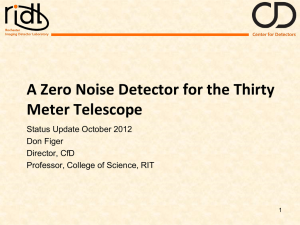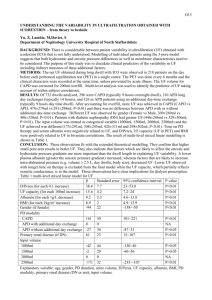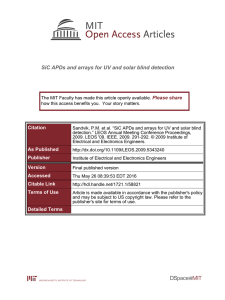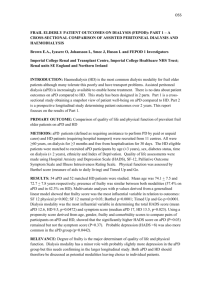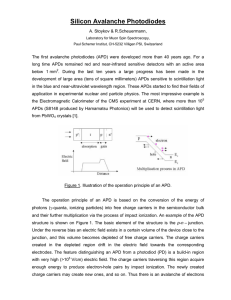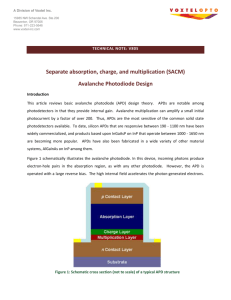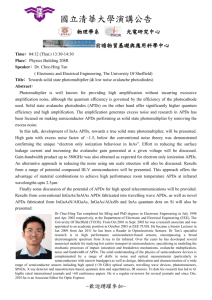Presentation
advertisement
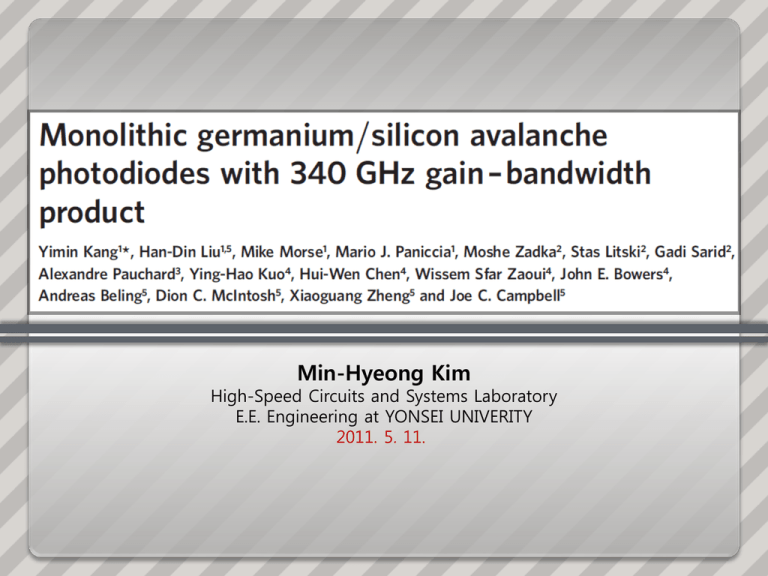
Min-Hyeong Kim High-Speed Circuits and Systems Laboratory E.E. Engineering at YONSEI UNIVERITY 2011. 5. 11. [ Contents ] 1. Abstract 2. Background - SACM APD structure - Ionization/multiplication coefficient 3. Device structure 4. Measurement results I. Dark current II. Excess noise factor & Gain-Bandwidth product III. Receiver sensitivity & BER 5. Conclusion 2 1. Abstract Monolithic Ge-Si SACM APD operating at 1300nm (separate absorption, charge and multiplication avalanche photodiodes) Gain-BW product : 340GHz K_eff : 0.09 A receiver sensitivity : -28dBm at 10Gb/s Si material properties allow for high gain with less excess noise than InPbased APD and a sensitivity improvement of 3dB or more. With Si, an even higher gain–bandwidth product could be achieved based on a simple layer structure with relatively large process tolerances. 3 2. Background Ⅰ. SACM APD (separate absorption, charge and multiplication APD) InAlAs-based APDs (Ref.17) InAlAs-based APDs (Ref.18) Si-based APDs (This work) 4 2. Background Ⅱ. Ionization/Multiplication coefficient K : Ratio of the ionization coefficients of electrons and holes. A low k value is desirable for high-performance APDs. Impact Ionization probability = W Multiplication coefficient M 1 W (W ) 2 (W )3 1 1 W ( for W 1) → Excess Noise factor F(M) kM (2 1 )(1 k ) M 5 3. Device structure SACM APD Punch through voltage -22V Breakdown voltage -25V with Responsivity 5.88A/W Designs for a floating guard ring (GR) with various distances (1–3 mm) between the guard ring and the mesa edge were introduced to reduce the surface electric field strength at the silicon/insulator interface to prevent premature breakdown along the device perimeter. 6 4. Measurement results Ⅰ. Dark current When the reverse bias increase, not only the gain becomes large but also the dark current increases. It is because of (1) junction leakage current (generation and recombination) and (2) tunneling current. T e L The breakdown voltage is -25V, and here at the dark current of 10uA. All these measurements are supported at 1300nm wavelength. 7 4. Measurement results Ⅱ. Excess noise factor & Gain-Bandwidth product 1 F(M) kM (2 )(1 k ) M After measurement of excess noise factor, the k value is calculated about to 0.09 by using above equation. All measured devices had a gain– bandwidth product over 300 GHz. The highest gain–bandwidth product obtained was 340 GHz. The 3dB BW was measured using Agilent 8703A Network Analyzer. The bandwidth is limited by RC and transit time effect. As the gain is increased beyond 20, the bandwidth dropped owing to the avalanche build-up time effect. 8 4. Measurement results A gain of 10 & -20dBm input optical power Ⅲ. Receiver sensitivity & BER APD+TIA+CDR for BER measurement A data rate of 10Gb/s Using a pseudo-random binary sequence(PRBS) and extinction ratio(ER) of 12dB. In this set, the input optical power(Receiver sensitivity) was maximun-28dBm. ** Sensitivity in a receiver is normally defined as the minimum input signal Si required to produce a specified signal-to-noise S/N ratio. (So, it is a function of the SNR or BER.) 9 5. Conclusion • To improve more, (1) Reducing the dark current of the APDs. : Better control of the germanium profile with respect to the electric field distribution in the device can reduce the tunneling current. (2) Reducing the value of k_eff. : Studies have shown that k_eff can be reduced by optimizing the multiplication region thickness. By this, we believe that a sensitivity of approximately -32 dB m could be achieved. • Demonstrate a monolithically grown, CMOS-compatible Ge-Si SACM APD device with a gain–bandwidth product of 340 GHz and a k_eff of 0.09 at 1300nm wavelength. • The optical receivers built with this Ge-Si APDs demonstrated a sensitivity of -28 dBm at 10Gb/s. 10

